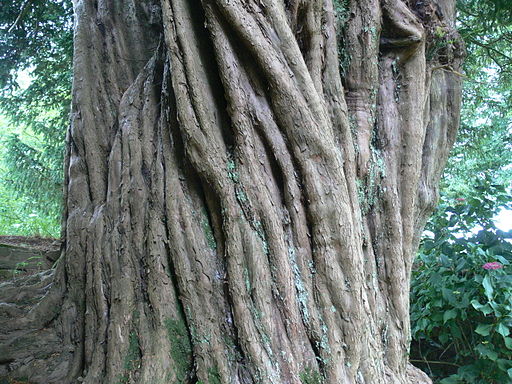Timberpedia - English Yew
English Yew
| Latin Name: | Irish Name: | Native to Ireland? |
|---|---|---|
| Taxus baccata | Iur | Yes |
About the Tree
Fossilized yew seeds in the peat bogs suggest this versatile and durable species is an indigenous
species to Ireland. The Yew Walk at Lisnavagh was planted by Daniel Robertson during the late
1840s, in the midst of an era when yews were being seriously planted in graveyards, cemeteries,
demesnes and landscaped gardens across the country. This beautiful long-lived tree with its redknotted heartwood and pale, creamy sapwood is poisonous to mankind, although blackbirds and
thrushes have been known to merrily intoxicate themselves on its berries and survive. (Turtle
Bunbury)
Almost every churchyard in Ireland has a yew tree. In pre-Christian times the Yew was associated
with religious sites. Can live for up to 2,000 years.
About the Wood
The Yew has been long prized for its wood, both for decorative cabinet-making and for its
durability. Yew was the wood of choice for making bows. A very dense softwood with a close
grain which finishes smoothly. Ranges in colour from orange to rich brown.
Has a tendency to develop shakes when drying. Tearout during planning is common. Takes a very
good finish. Very suitable for woodcarving. Very hard when dry.
The timber was especially popular with cabinetmakers in the late Victorian age.
Know your wood! The Timberpedia is a broad resource that aims to catalogue all the major tree species in Ireland, containing information that we’ve gathered from over two decades maintaining our natural woodland and serving Ireland’s woodworking industry.
All written material is copyright © 2021 by the Lisnavagh Timber Project.
Timberpedia
- Acacia
- Alder (Common)
- Apple
- Apple (Crab)
- Apple (Japanese Crab)
- Ash
- Aspen (Trembling Poplar)
- Beech
- Beech (Copper)
- Beech (Southern)
- Birch
- Box
- Cedar (Western Red)
- Cedar of Lebanon
- Cherry (Bird)
- Cherry (Wild) / Gean
- Chestnut (Horse)
- Chestnut (Sweet / Spanish)
- Cypress (Lawson)
- Cypress (Monterey)
- Elm (English)
- Elm (Wych)
- Eucalyptus
- Fir (Douglas)
- Fir (Grand/Giant)
- Fir (Noble)
- Fir (Silver/European)
- Hawthorn
- Hazel
- Holly
- Hornbeam
- Ivy
- Laburnum
- Larch (European)
- Larch (Japanese)
- Larch (Red)
- Laurel
- Lime
- Maidenhair Tree
- Maple (Field)
- Maple (Norway)
- Mimosa / Silver Wattle
- Monkey-Puzzle
- Musk (Olearia)
- Oak (Cork)
- Oak (Holm / Holly / Evergreen)
- Oak (Pedunculate / English)
- Oak (Red)
- Oak (Sessile / Irish)
- Oak (Turkey)
- Pear
- Pine
- Pine (Scots)
- Plane (London / Lacewood)
- Poplar (Black Cottonwood / Western Balsam)
- Poplar (Grey)
- Rowan (Mountain Ash)
- Spruce (Norway)
- Spruce (Sitka)
- Sycamore
- Tulip Tree
- Walnut (Black)
- Walnut (Common)
- Wellingtonia
- Western Hemlock
- Whitebeam
- Wild Service Tree
- Willow
- Willow (Bay)
- Willow (Crack)
- Willow (Cricket Bat)
- Willow (Goat / Sallow)
- Willow (White / Silver)
- Yew (English)
- Yew (Irish)




